Brightwood CollegeBrightwood College - NURSING 119.Grade A
Document Content and Description Below
Chapter 55: Assessment of Nervous System Lewis: Medical-Surgical Nursing, 10th Edition MULTIPLE CHOICE 1. When admitting an acutely confused patient with a head injury, which action should the... nurse take? a. Ask family members about the patient’s health history. b. Ask leading questions to assist in obtaining health data. c. Wait until the patient is better oriented to ask questions. d. Obtain only the physiologic neurologic assessment data. 2. Which finding would the nurse expect when assessing the legs of a patient who has a lower motor neuron lesion? a. Spasticity c. Impaired sensation b. Flaccidity d. Hyperactive reflexes 3. The nurse performing a focused assessment of left posterior temporal lobe functions will assess the patient for a. sensation on the left side of the body. b. reasoning and problem-solving ability. c. ability to understand written and oral language. d. voluntary movements on the right side of the body. 4. Propranolol (Inderal), a -adrenergic blocker that inhibits sympathetic nervous system activity, is prescribed for a patient who has extreme anxiety about public speaking. The nurse monitors the patient for a. dry mouth. c. constipation. b. bradycardia. d. urinary retention. 5. To assess the functions of the trigeminal and facial nerves (CNs V and VII), the nurse should a. check for unilateral eyelid droop. b. shine a light into the patient’s pupil. c. touch a cotton wisp strand to the cornea. d. have the patient read a magazine or book. 6. Which action will the nurse include in the plan of care for a patient with impaired functioning of the left glossopharyngeal nerve (CN IX) and vagus nerve (CN X)? a. Assist to stand and ambulate. c. Insert an oropharyngeal airway. b. Withhold oral fluids and food. d. Apply artificial tears every hour. . 7. An unconscious male patient has just arrived in the emergency department with a head injury caused by a motorcycle crash. Which order should the nurse question? a. Obtain x-rays of the skull and spine. b. Prepare the patient for lumbar puncture. c. Send for computed tomography (CT) scan. d. Perform neurologic checks every 15 minutes. 8. A patient with suspected meningitis is scheduled for a lumbar puncture. Before the procedure, the nurse will plan to a. enforce NPO status for 4 hours. b. transfer the patient to radiology. c. administer a sedative medication. d. help the patient to a lateral position. 9. During the neurologic assessment, the patient is unable to respond verbally to the nurse but cooperates with the nurse’s directions to move his hands and feet. The nurse will suspect a. cerebellar injury. c. frontal lobe damage. b. a brainstem lesion. d. a temporal lobe lesion. 10. A patient has a tumor in the cerebellum. The nurse will plan interventions to a. prevent falls. c. avoid aspiration. b. stabilize mood. d. improve memory. 11. Which problem can the nurse expect for a patient who has a positive Romberg test result? a. Pain c. Aphasia b. Falls d. Confusion 12. The nurse will anticipate teaching a patient with a possible seizure disorder about which test? a. Cerebral angiography c. Electromyography (EMG) b. Evoked potential studies d. Electroencephalography (EEG) 13. Which nursing action will be included in the plan of care for a patient who has had cerebral angiography? a. Monitor for headache and photophobia. b. Keep patient NPO until gag reflex returns. c. Check pulse and blood pressure frequently. d. Assess orientation to person, place, and time. 14. Which equipment will the nurse obtain to assess vibration sense in a patient with diabetes who has peripheral nerve dysfunction? a. Sharp pin c. Reflex hammer b. Tuning fork d. Calibrated compass 15. Which information about a 76-yr-old patient should the nurse report as uncharacteristic of normal aging? a. Triceps reflex response graded at 1/5 b. Unintended weight loss of 15 pounds c. 10 mm Hg orthostatic drop in systolic blood pressure d. Patient complaint of chronic difficulty in falling asleep 16. The charge nurse is observing a new staff nurse who is assessing a patient with a traumatic spinal cord injury for sensation. Which action indicates a need for further teaching of the new nurse about neurologic assessment? a. The new nurse tests for light touch before testing for pain. b. The new nurse has the patient close the eyes during testing. c. The new nurse asks the patient if the instrument feels sharp. d. The new nurse uses an irregular pattern to test for intact touch. 17. Which cerebrospinal fluid analysis result should the nurse recognize as abnormal and communicate to the health care provider? a. Specific gravity of 1.007 b. Protein of 65 mg/dL (0.65 g/L) c. Glucose of 45 mg/dL (1.7 mmol/L) d. White blood cell (WBC) count of 4 cells/L 18. A 39-yr-old patient with a suspected herniated intervertebral disc is scheduled for a myelogram. Which information communicated by the nurse to the health care provider before the procedure would change the procedural plans? a. The patient is anxious about the test results. b. The patient reports a previous allergy to shellfish. c. The patient has back pain when lying flat for more than 4 hours. d. The patient drank apple juice 4 hours before the scheduled procedure. 19. The priority nursing assessment for a patient being admitted with a brainstem infarction is a. pupil reaction. c. reflex reaction time. b. respiratory rate. d. level of consciousness. 20. Several patients have been hospitalized for diagnosis of neurologic problems. Which patient will the nurse assess first? a. A patient with a transient ischemic attack (TIA) returning from carotid duplex studies b. A patient with a brain tumor who has just arrived on the unit after a cerebral angiogram c. A patient with a seizure disorder who has just completed an electroencephalogram (EEG) d. A patient prepared for a lumbar puncture whose health care provider is waiting for assistance MULTIPLE RESPONSE 1. Which assessments will the nurse make to monitor a patient’s cerebellar function (select all that apply)? a. Test for graphesthesia. b. Observe arm swing with gait. c. Perform the finger-to-nose test. d. Assess heat and cold sensation. e. Measure strength against resistance. [Show More]
Last updated: 2 years ago
Preview 1 out of 4 pages

Buy this document to get the full access instantly
Instant Download Access after purchase
Buy NowInstant download
We Accept:

Reviews( 0 )
$5.00
Can't find what you want? Try our AI powered Search
Document information
Connected school, study & course
About the document
Uploaded On
Jan 02, 2020
Number of pages
4
Written in
Additional information
This document has been written for:
Uploaded
Jan 02, 2020
Downloads
0
Views
121


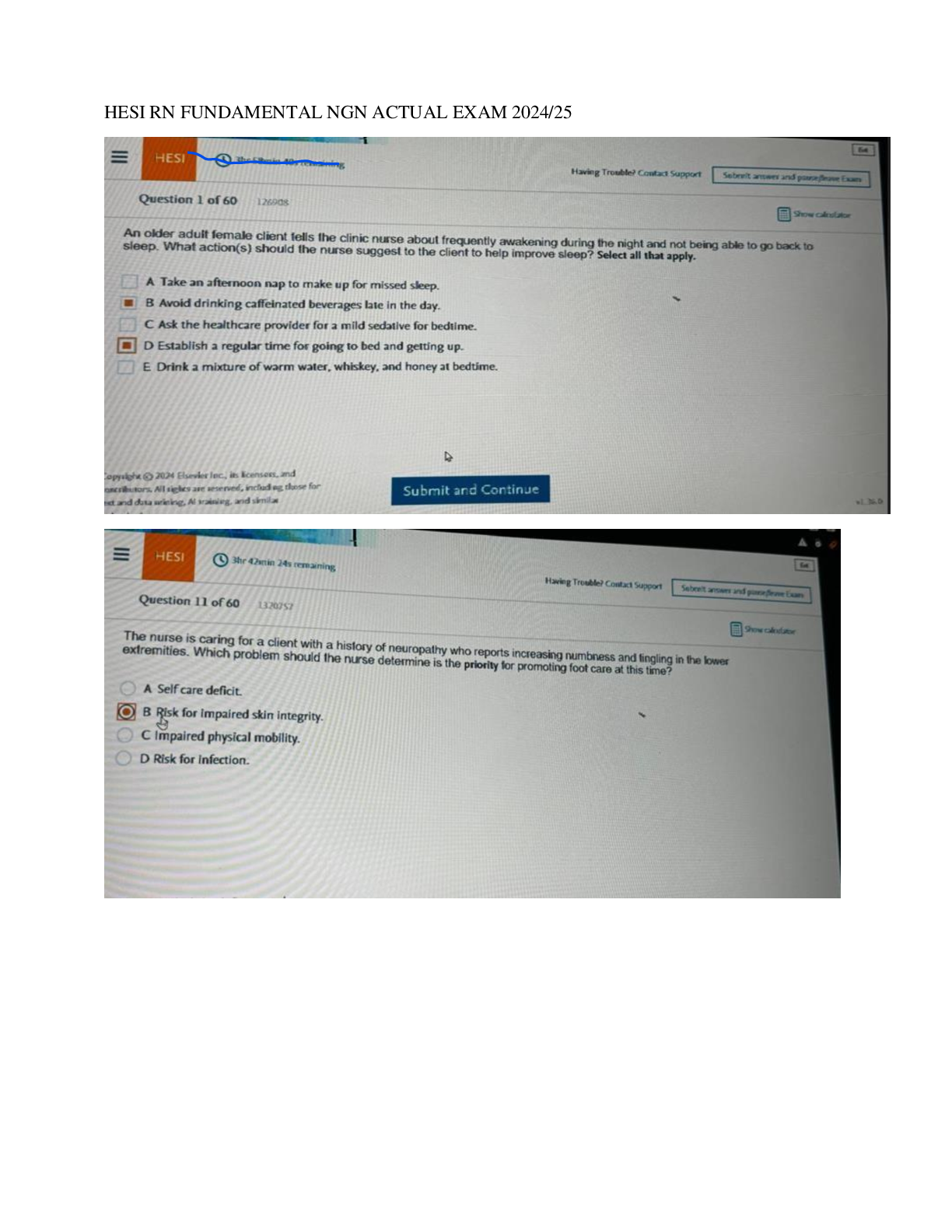
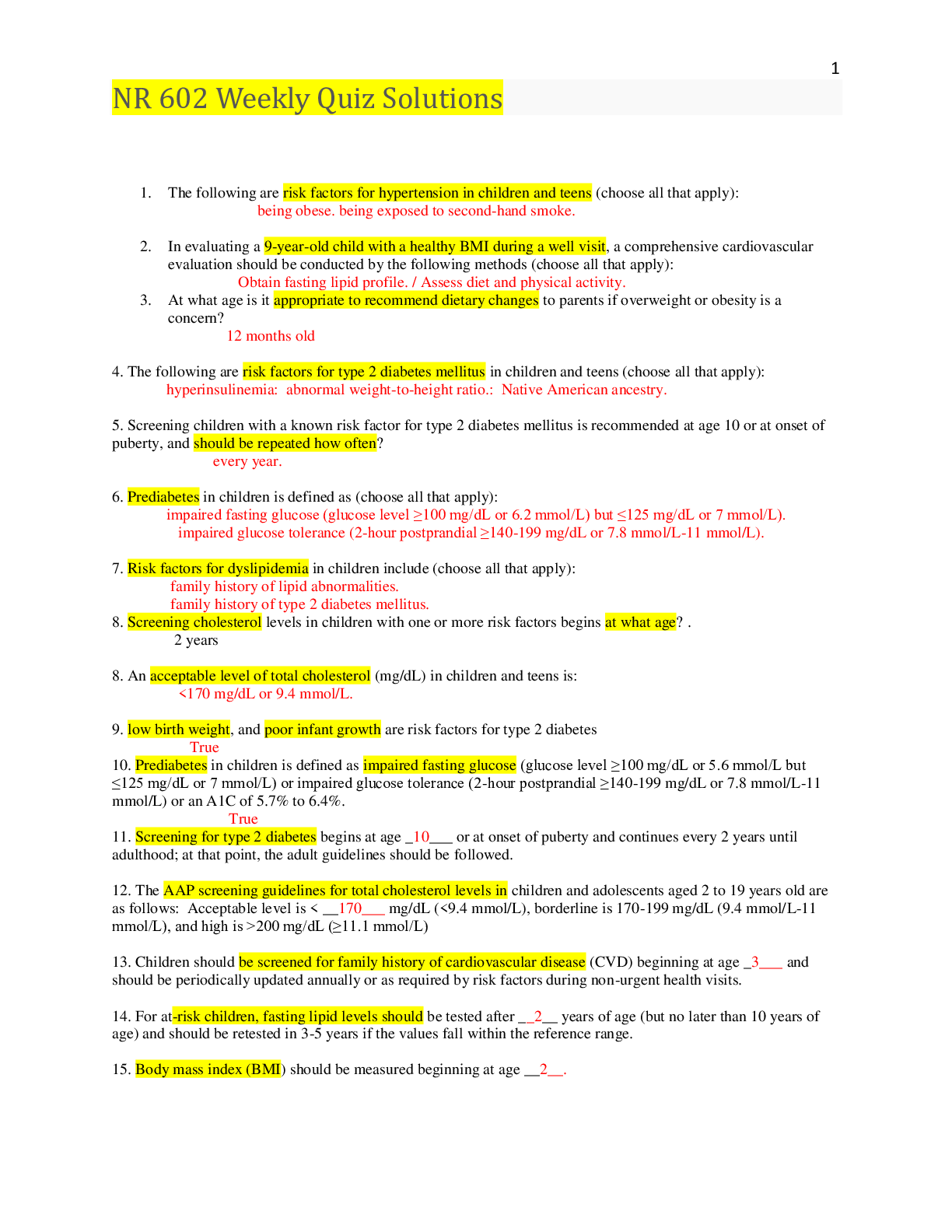
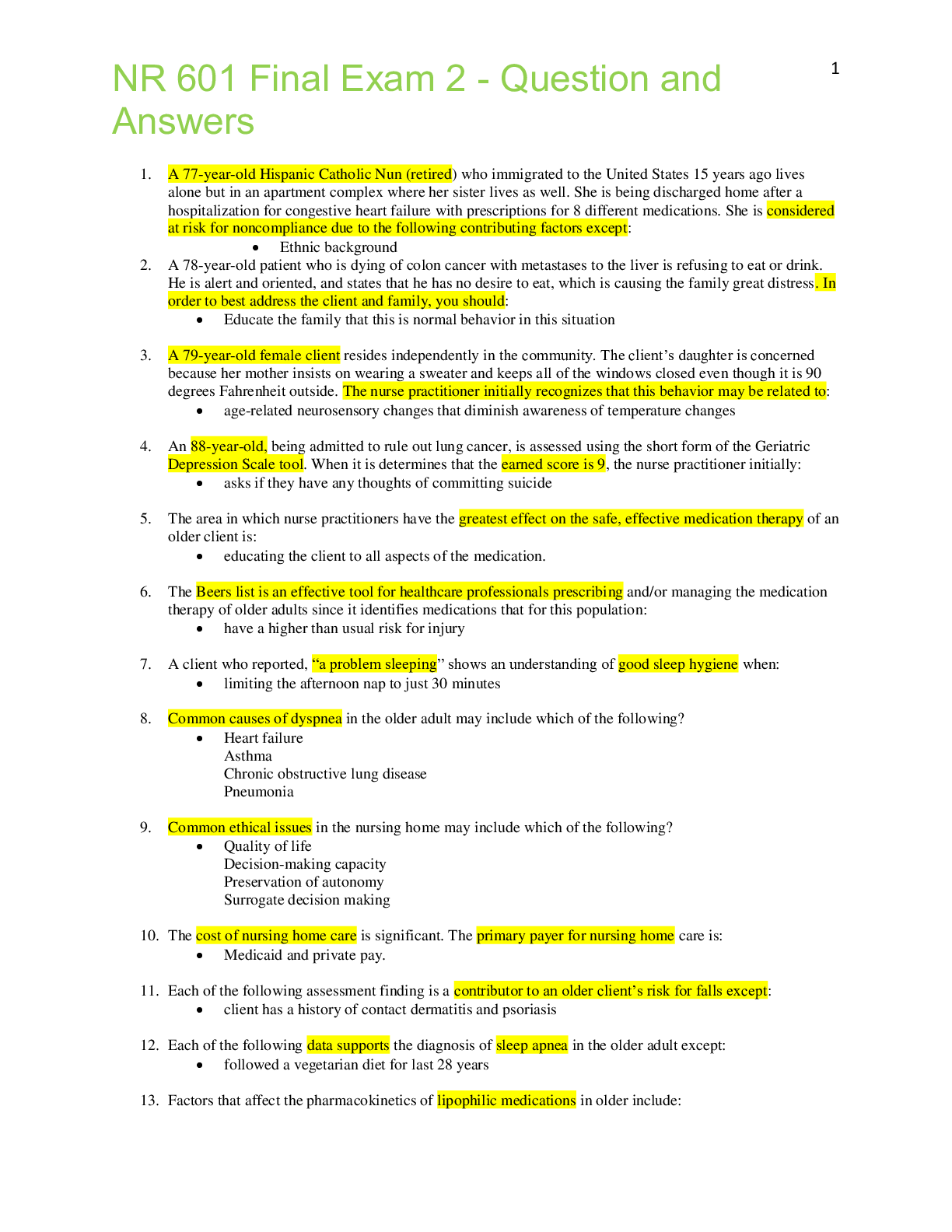
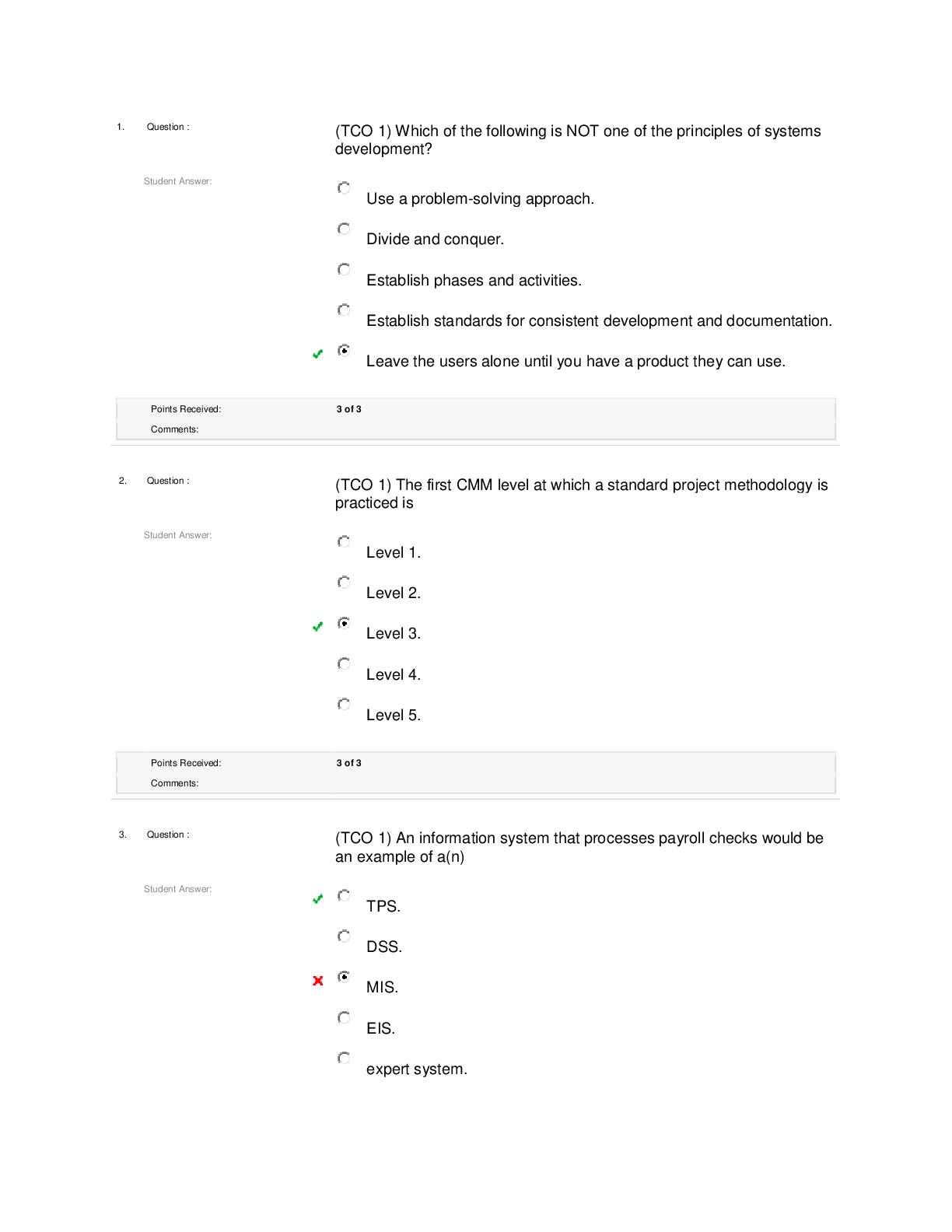

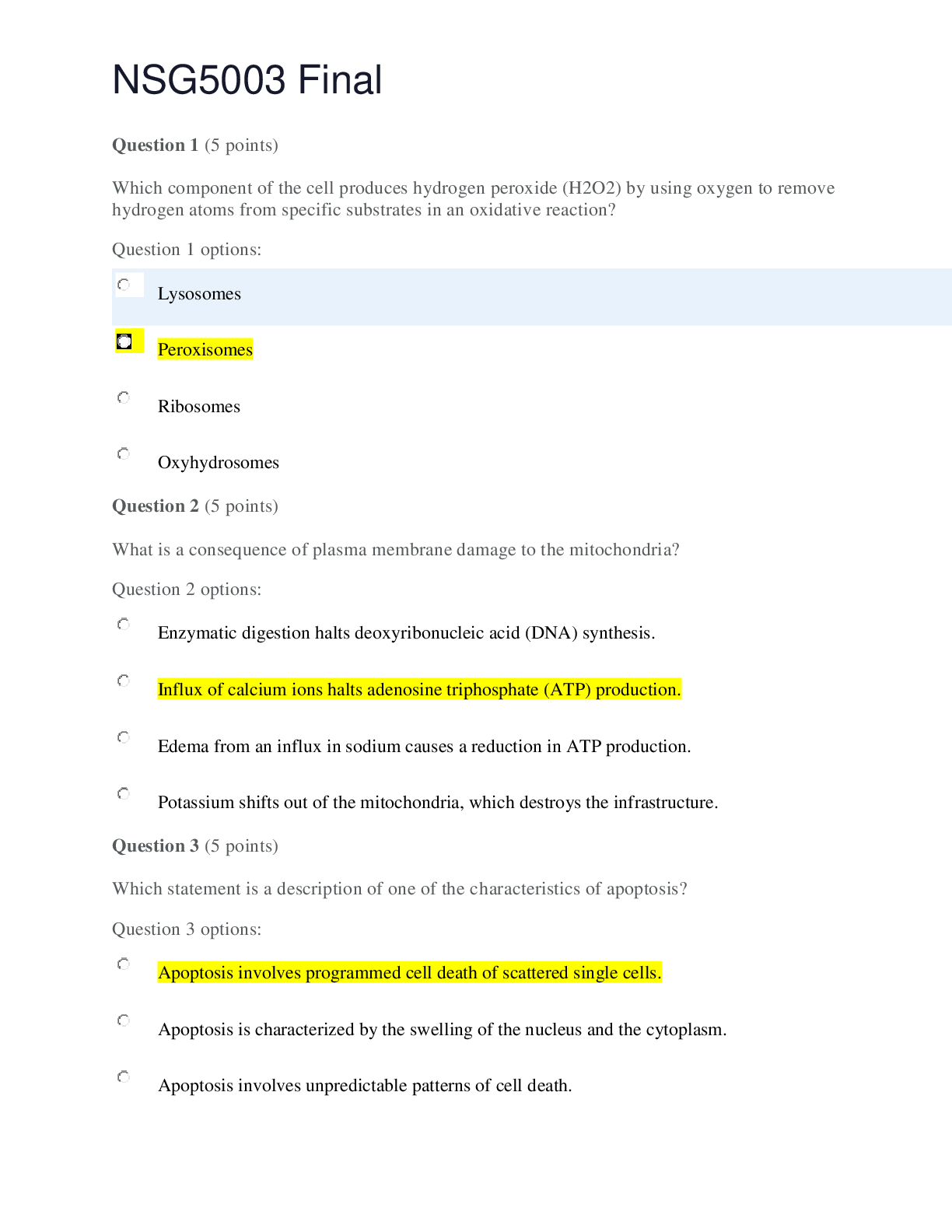
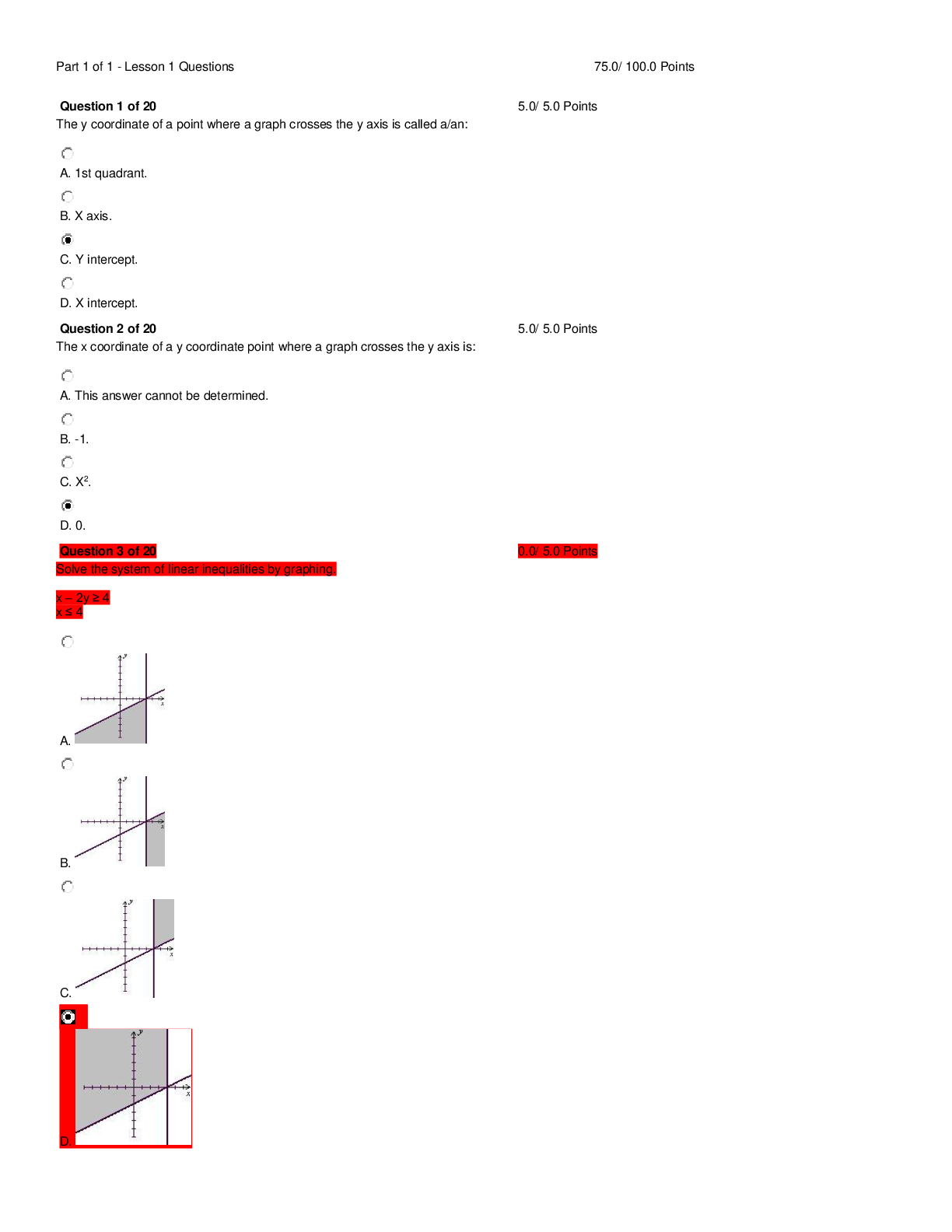
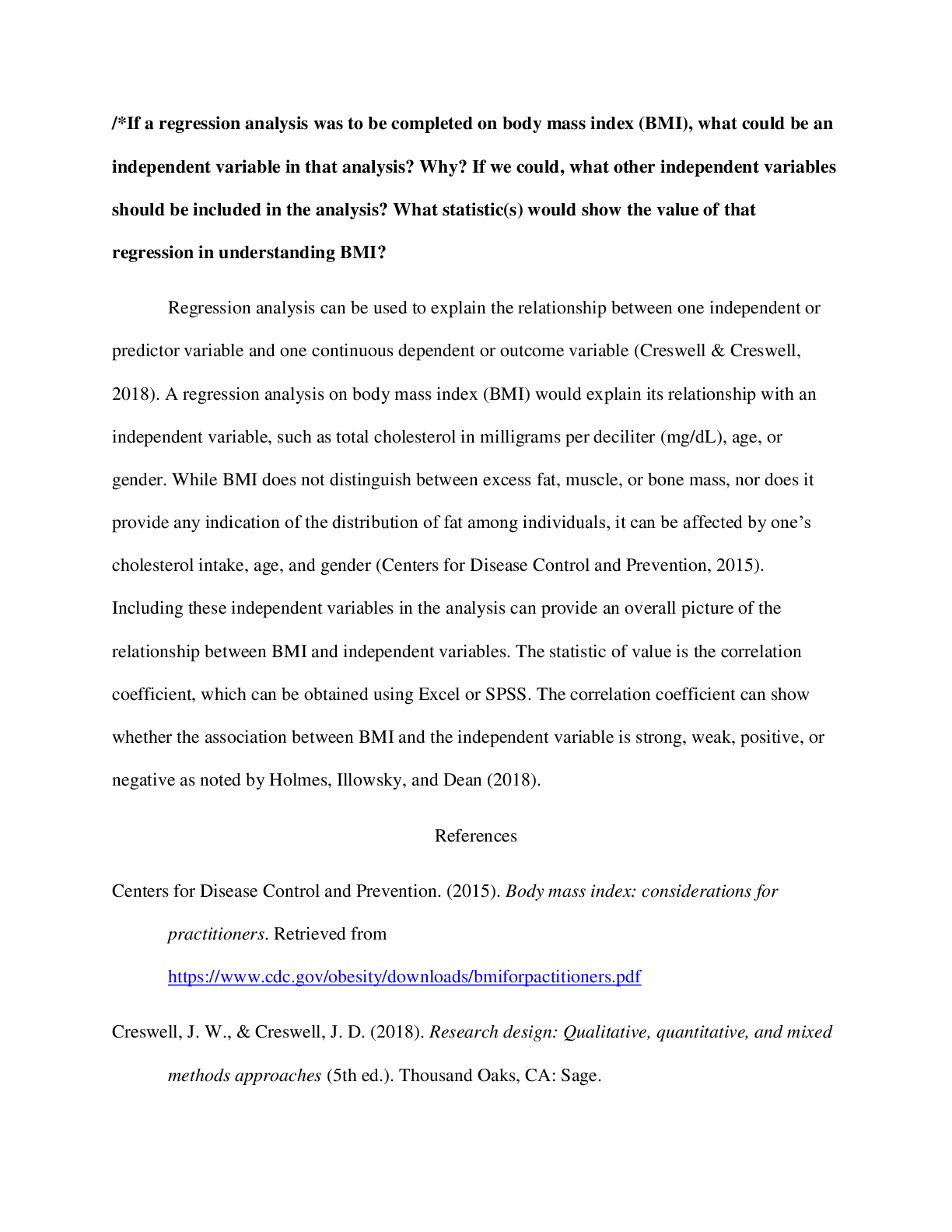


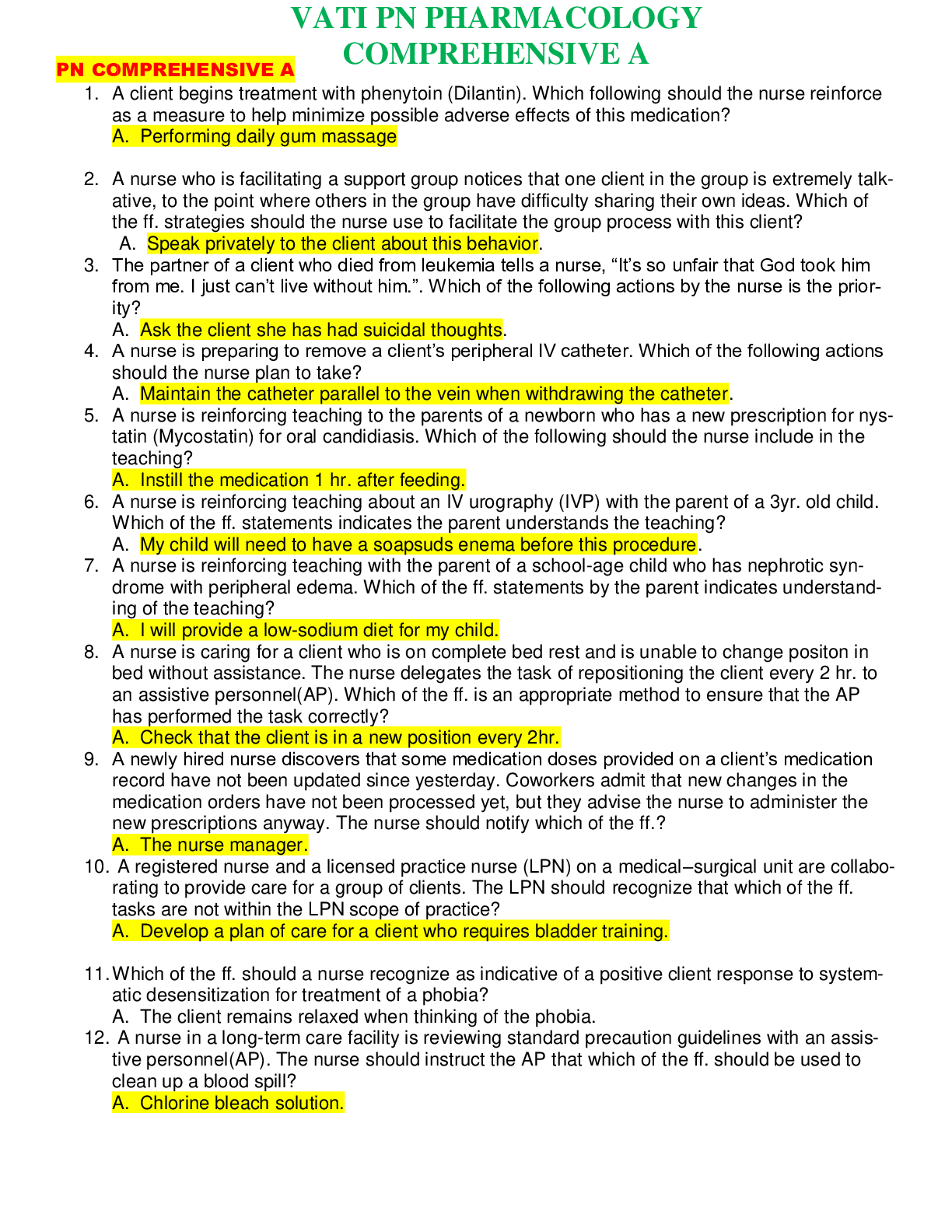
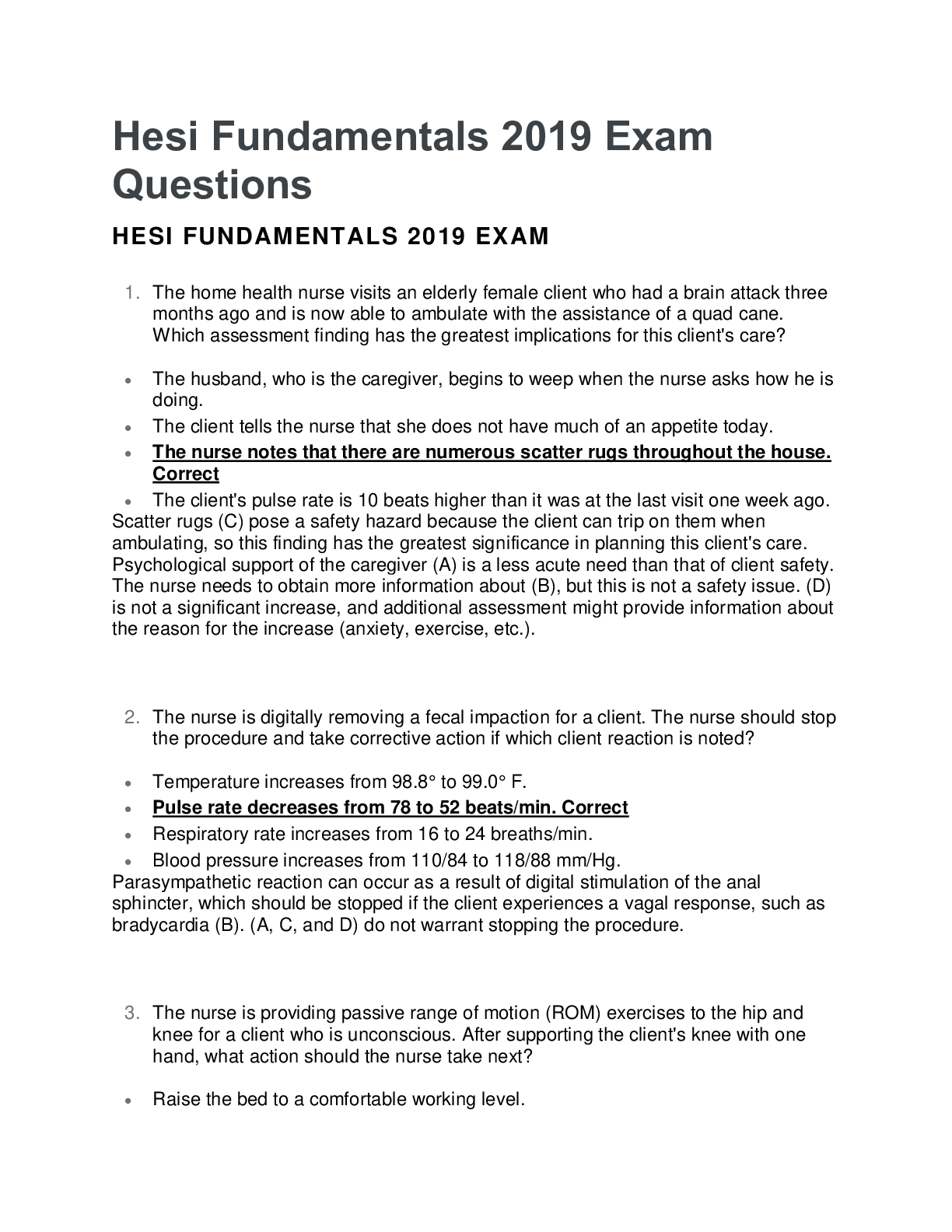
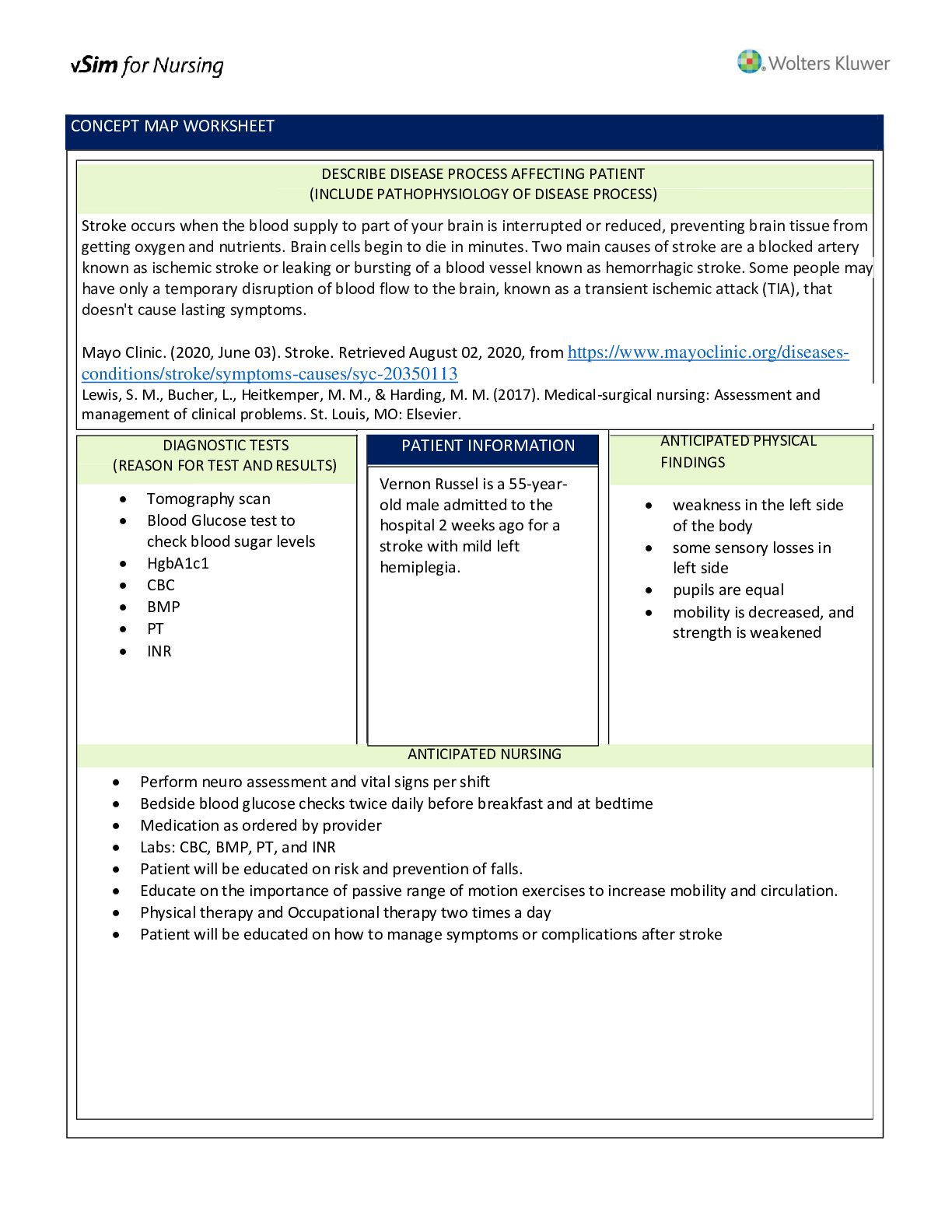


.png)







